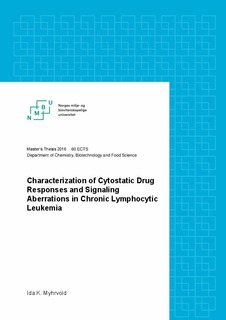| dc.contributor.advisor | Taskén, Kjetil | |
| dc.contributor.advisor | Lea, Tor | |
| dc.contributor.advisor | Skånland, Sigrid S. | |
| dc.contributor.author | Myhrvold, Ida Kristin | |
| dc.date.accessioned | 2016-08-09T07:18:44Z | |
| dc.date.available | 2016-08-09T07:18:44Z | |
| dc.date.issued | 2016-08-09 | |
| dc.identifier.uri | http://hdl.handle.net/11250/2398246 | |
| dc.description.abstract | Chronic Lymphocytic Leukemia (CLL) is a heterogeneous disease with variable clinical courses. The disease is incurable, but a third to half of the patients may never need treatment. For those who need treatment, the options are limited and it is important to prevent them from exposure to ineffective therapy. The work presented in this master thesis is part of a larger project where the long-term goal is to tailor the treatment of CLL patients on an individual basis according to patients’ biology and prognosis. The contributions to this goal were to establish phosphoflow cytometry as a method to analyse phosphorylation events in B cells from CLL patients and healthy donors in the lab. Applying this method, basal and induced phosphorylation levels in CLL cells relative to healthy controls were investigated in order to map aberrations which can provide indications for targeted therapy. The effects of the cytostatic drugs fludarabine, doxorubicin and vincristine on basal and induced levels of phosphorylation were also investigated.
The study showed that B cells from CLL patients exerted lower basal levels of phosphorylation of certain proteins relative to healthy controls. In general, the cytostatic drugs reversed this effect. Interestingly, STAT3 (pTyr705) known to be associated with hematological malignancies, was upregulated in CLL cells compared to healthy controls. After BCR stimulation with anti-IgM, and fludarabine or doxorubicin treatment, Akt (pSer473) and p44/42 MAPK (pThr202/Tyr204) were enhanced in CLL samples relative to healthy controls. Importantly, the PI3K inhibitor idelalisib potently reversed the effect of fludarabine on Akt (pSer473). Finally, CD40 signaling was investigated, presenting a notable increase in Akt (pSer473). In combination with fludarabine, doxorubicin or vincristine, the CD40L-induced phosphorylation was enhanced for several parameters. These drugs are currently in use for the treatment of CLL and will be used in combination studies in a future large-scale drug screen.
The work presented in this thesis has added to the mapping of basal, anti-IgM and CD40L-induced protein phosphorylation in CLL cells compared to healthy B cells by the use of phosphoflow cytometry analysis. Furthermore, it has provided important information on phosphorylation induced by the cytostatic drugs fludarabine, doxorubicin and vincristine. The findings reported here will be of value in the following studies which ultimately aim to provide personalized treatment of CLL patients. | nb_NO |
| dc.description.abstract | Kronisk lymfatisk leukemi (KLL) er en heterogen sykdom med variabelt klinisk sykdomforløp. Det finnes i dag ingen helbredende behandling. For én tredjedel til halvparten av pasientene vil det aldri være nødvendig med behandling, men for de som trenger det, er tilbudet begrenset. I tillegg er forekomsten av KLL kraftig økende og det er dermed stigende etterspørselen etter et behandlingstilbud utover annenlinjebehandling. Arbeidet presentert i denne oppgaven er del av et større prosjekt hvor det langsiktige målet er å skreddersy behandlingen av KLL pasienter på et individuelt nivå. Som bidrag til dette har fosfovæskestrømscytometri blitt etablert i laben som metode for å analysere proteinfosforylering i B celler fra KLL pasienter og friske donorer. Ved hjelp av denne metoden har basal og indusert fosforylering i KLL og friske B celler blitt sammenlignet for å kartlegge avvik som kan indikere mål for terapi. Videre ble de cytostatiske medikamentene fludarabin, doksorubicin og vinkristin studert for å karakterisere deres effekt på basal og indusert fosforylering. Disse medikamentene er i bruk ved behandling av KLL og vil senere bli brukt i kombinasjonsstudier for screening av legemidler.
Studiet viste lavere basalt nivå av fosforyleringen av visse signalproteiner i B celler fra KLL pasienter relativt til friske donorer. Generelt ble denne effekten reversert av de cytostatiske medikamentene. STAT3 (pTyr705), kjent for å være assosiert med hematologiske kreftformer, var oppregulert i KLL celler sammenlignet med kontrollceller. Etter BCR stimulering med anti-IgM og behandling med fludarabin eller doksorubicin, var det en økning av Akt (pSer473) og p44/42 MAPK (pThr202/Tyr204) i KLL celler sammenlignet med friske kontroller. Den observerte effekten av fludarabin på Akt (pSer473) ble kraftig reversert ved bruk av PI3K hemmeren idelalisib. Til slutt ble CD40 signalering undersøkt. CD40 stimulering resulterte i en økning av Akt (pSer473) og i kombinasjon med fludarabin, doksorubicin eller vinkristin, viste en rekke parametre økt fosforylering.
Arbeidet presentert i denne oppgaven har ved bruk av fosfovæskestrømscytometri bidratt til å kartlegge basal, anti-IgM- og CD40L-indusert proteinfosforylering i KLL celler sammenlignet med friske B celler. Videre har det bidratt til viktig kunnskap om de effekter fludarabin, doksorubicin og vinkristin har på proteinfosforylering. Disse funnene vil være viktige i det videre arbeidet med å utvikle skreddersydd behandling av KLL pasienter. | nb_NO |
| dc.language.iso | eng | nb_NO |
| dc.publisher | Norwegian University of Life Sciences, Ås | |
| dc.subject | CLL | nb_NO |
| dc.subject | Chronic Lymphocytic Leukemia | nb_NO |
| dc.subject | Cytostatic drug responses | nb_NO |
| dc.subject | Signaling aberrations | nb_NO |
| dc.title | Characterization of cytostatic drug responses and signaling aberrations in chronic lymphocytic leukemia | nb_NO |
| dc.title.alternative | Karakterisering av cellegiftresponser og signalendringer i kronisk lymfatisk leukemi | nb_NO |
| dc.type | Master thesis | nb_NO |
| dc.subject.nsi | VDP::Mathematics and natural science: 400 | nb_NO |
| dc.source.pagenumber | 62 | nb_NO |
| dc.description.localcode | M-BIOTEK | nb_NO |
